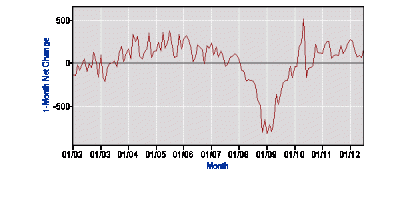
This person is working! As a stock photo model.
Wake up, wake up, wake up, wake up. Get up, get up, get up, get up.
It’s the first Friday of the month, which means that the Bureau of Labor Statistics (BLS) released its summary of employment for the month preceding.
And, hey! It’s not terrible news. The economy added 163,000 jobs in July. The private sector added 172,000; the public sector (that is, government) lost another 9,000. The unemployment rate (which is pegged to slightly different data) went from 8.2 to 8.3 percent — but that’s because the rate inched to 8.254 and was then rounded up. In order to keep up with population growth, we need more than 125,000 new jobs added a month — so that’s some good news.
Since Obama took office, this is what the private and public sectors have done. The blue line is government, which saw a one-time spike from Census hiring.

The key point in this graph: Government has been shrinking for years. Or, to put it more snarkily:
Since Obama began growing the govt, 648k public jobs have been shed.
#NFP— Duke (@DukeStJournal) August 3, 2012
Overall, most segments of the population remained steady this month — not good news, not bad. As for individual sectors of the economy:
Employment in professional and business services increased by 49,000 in July. Computer systems design added 7,000 jobs, and employment in temporary help services continued to trend up (+14,000).
Within leisure and hospitality, employment in food services and drinking places rose by 29,000 over the month and by 292,000 over the past 12 months.
Manufacturing employment rose in July (+25,000), with nearly all of the increase in durable goods manufacturing. Within durable goods, the motor vehicles and parts industry had fewer seasonal layoffs than is typical for July, contributing to a seasonally adjusted employment increase of 13,000. Employment continued to trend up in fabricated metal products (+5,000).
Employment continued to trend up in health care in July (+12,000), with over-the-month gains in outpatient care centers (+4,000) and in hospitals (+5,000). Employment also continued to trend up in wholesale trade.
Utilities employment declined in July (-8,000). The decrease reflects 8,500 utility workers who were off payrolls due to a labor-management dispute.
That utility employment figure largely reflects a labor dispute at New York’s Con Edison. Green employment is not a separate indicator within the BLS’ monthly numbers, though jobs in renewable energy and recycling, for example, are contained in other data points. It would certainly be helpful to have a clearer, ongoing assessment of how the sector evolves month over month, but that’s undoubtedly a ways away. After all, the odds are pretty good that the BLS isn’t exactly fully staffed anymore.
To put this month in perspective, here is what employment has looked like over the past decade.
Or, if you prefer to compare it to previous recessions, see what Business Insider calls “the scariest jobs chart ever.” It lives up to its title.
So! In short: not bad news for the economy, not fantastic news. If you are looking for a little entertainment, check out how politicians and their allies on both sides of the fence are spinning the report. 8.3 percent! Doomsday! — or — 172,000 jobs! Hurrah!
Ain’t politics grand?




